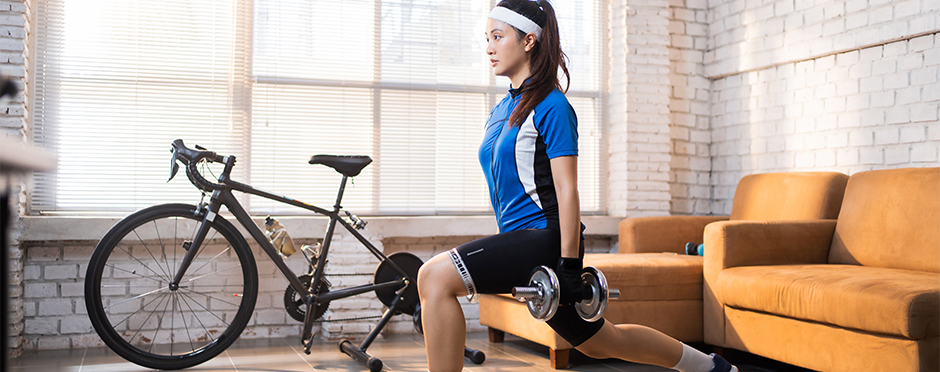
Cross-Training for Runners
Leave a CommentRunning is a demanding activity, both physically and mentally. Thirty to seventy five percent of runners are hurt annually. But why? Shoe wear, stretching, biomechanics, weight and muscle imbalance can all be contributing factors in running-related injuries. A common reason for injuries in runners is repetition. Recent studies have shown multi-sport athletes have improved longevity of sport and reduced risk for injury due to variation. One simple way to reduce injury risk for runners is cross-training. Cross-training is a form of exercise, which utilizes a variety of different training mechanisms to improve physical fitness. Runners utilize cross-training for injury prevention and rehabilitation, a change of pace and increased physical fitness.
Benefits of Cross-Training
-
Muscular balance
- Running alone trains a very specific group of muscles. By participating in cross-training, different muscles are worked than those typically used during running. This can help to prevent muscle imbalances, therefore reducing the potential for injuries. Things that can be changed to ensure muscular balance during cross-training are: movement patterns, resistance and repetitions.3
-
Physical fitness/conditioning
- When performing different forms of exercise, cardiovascular endurance can also improve. Cross-training not only helps increased running efficiency, but also power. Both of these things are important for improving training time while decreasing the risk for injury or fatigue.2
-
Injury reduction
- As described above, running only trains certain muscles, which can cause “muscular imbalance.” By engaging in cross-training, different muscle groups can be worked to reduce the potential for injury caused by these muscular imbalances.2 Cross-training also reduces the amount of repetition performed in a running movement without losing the strength or cardiovascular benefits. Low-impact activities such as swimming or cycling can also reduce the amount of stress placed on the joints during running.5
-
Increased healing time
- Cross-training can also allow for the body to “heal” from the running activities performed, while also continuing to train and gain the above effects.3
Forms of Cross-Training
-
Swimming
- Swimming is a low-impact and excellent form of cross-training. Water helps to reduce the stress on joints, while still working to strengthen muscles with the resistance. It is a great way to build strength, endurance and flexibility. Swimming is a full body activity, putting less stress on your lower body, while incorporating your upper body3.
-
Cycling
- Cycling is a great activity for cardiovascular exercise and strengthening. Cycling specifically works to strengthen glutes and quads, which are often underutilized during running.3
-
Strength training
- Strength training is good for building muscular endurance and strength. All muscles can be worked in complex and isolated movements during strength training. Strength training can be varied as stated previously by using different movement patterns, resistance type, and number of repetitions, including sets and reps. Strength training can consist of bodyweight exercises, weight lifting, and resistance bands.3
-
Pilates/yoga
- Pilates and yoga are good forms of training to improve joint and core stabilization, as well as flexibility. Flexibility, core stability and joint stability are important for runners and should be incorporated into all running programs.3
Cross-training is an effective and efficient way to improve physical fitness and prevent injuries for runners. Building an all-inclusive program is the key to success for runners. Seek professional advice from one of Athletico’s endurance experts regarding your current running program.
Athletico is now offering free assessments in-clinic and online through our telehealth platform. If you notice abnormal soreness, aches or pains with a cross-training routine, contact Athletico. Our team will assess your pain and provide recommendations for a treatment plan.
The Athletico blog is an educational resource written by Athletico employees. Athletico bloggers are licensed professionals who abide by the code of ethics outlined by their respective professional associations. The content published in blog posts represents the opinion of the individual author based on their expertise and experience. The content provided in this blog is for informational purposes only, does not constitute medical advice and should not be relied on for making personal health decisions.
References:
1. Duffek, J. (2018, February 08). Specialization or multisport participation? Here’s what the data says. Retrieved August 24, 2020, from https://usatodayhss.com/2018/specialization-or-multisport-participation-heres-what-the-data-says
2. Fitzgerald, M. (2004, November 22). Eight benefits of cross-training. Retrieved August 24, 2020, from https://www.runnersworld.com/training/a20813186/eight-benefits-of-cross-training/
3. Luff, C. (2020, July 27). The benefits of cross-training for runners.
4. Matthews, J. (2009, September 02). What is cross training and why is it important? Retrieved August 24, 2020, from https://www.acefitness.org/education-and-resources/lifestyle/blog/36/what-is-cross-training-and-why-is-it-important/
5. Millard, E. (2020, July 21). Want to live longer? Prioritize both aerobic and strength-training activities. Retrieved August 24, 2020, from https://www.runnersworld.com/news/a33300768/cross-training-impact-on-longevity-study/
6. Powell, A. (2019, March 04). Where runners go wrong. Retrieved August 24, 2020, from https://news.harvard.edu/gazette/story/2016/02/where-runners-go-wrong/
